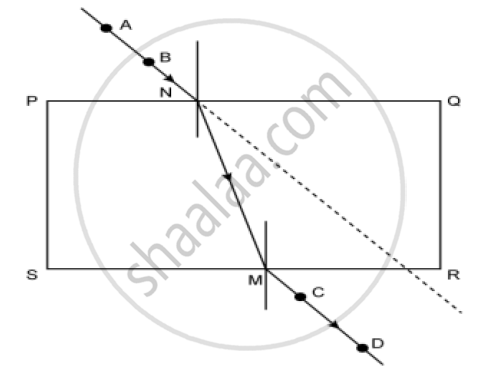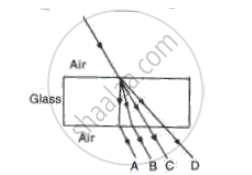Advertisements
Advertisements
प्रश्न
A monochromatic ray of light passes from air to glass. The wavelength of light in air is λ, the speed of light in air is c and in glass is V. If the absolute refractive index of glass is 1.5, write down
- the relationship between c and V,
- the wavelength of light in glass.
उत्तर
aμg = 1.5, aμg = `"speed of light in air"/"speed of light in glass" = c/V`
- μ or c = aμg × V = 1.5 V
- aμg = `"wave length of light in air"/"wave length of light in glass"`
∴ wave length of light in glass = `λ/ 1.5`
APPEARS IN
संबंधित प्रश्न
Choose the correct alternative and rewrite the following sentence.
A ray of light strikes the glass slab at an angle of 50°. What is the angle of incidence?
Write a short note on dispersion of light.
After tracing the path of a ray of light passing through a rectangular glass slab for four different values of the angle of incidence, a student reported his observations in tabular form as given below:
| S.No | ∠ i | ∠ r | ∠ e |
| I | 30° | 19° | 29° |
| II | 40° | 28° | 40° |
| III | 50° | 36° | 50° |
| IV | 60° | 40° | 59° |
The best observation is
(A) I
(B) II
(C) III
(D) IV
Four students P, Q, R and S traced the path of a ray of light passing through a glass slab for an angle of incidence 40° and measured the angle of refraction. The values as measured them were 18°; 22°; 25° and 30° respectively. The student who has performed the experiment methodically is
(A) P
(B) Q
(C) R
(D) S
Name one factor that affects the lateral displacement of light as it passes through a rectangular glass slab.
Observe the following figure and answer the questions given under it:

1) How many times does refraction take place in the above figure?
2) What happens to the ray of light when it passes from air to glass?
3) What happens to the ray of light when it passes from glass to air?
4) What are the rays AB and CD in the figure called?
5) Define refraction.
How does the angle of minimum deviation produces by a prism change with increase in :
the wavelength of incident light
Select from the following the best experimental set-up for tracing the path of a ray of light through a glass slab: (A) I
(A) I
(B) II
(C) III
(D) IV
In the fig. name the ray which represents the correct path of light while passing through a glass block.

What do you understand by the deviation produced by a prism?
